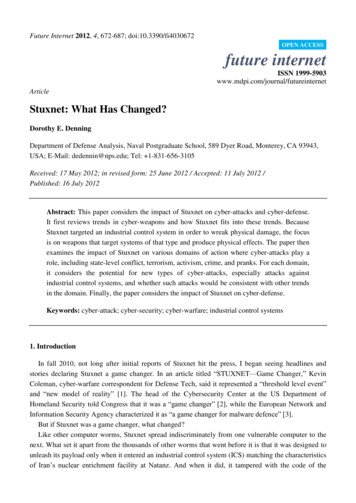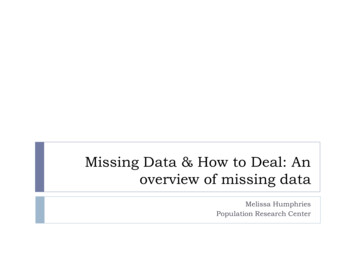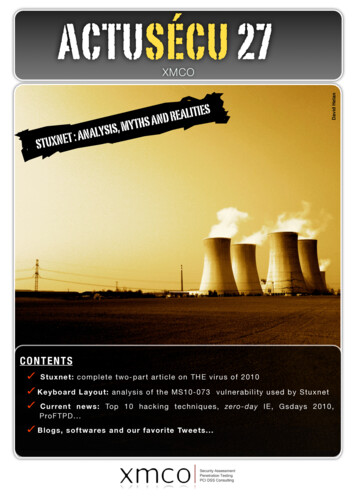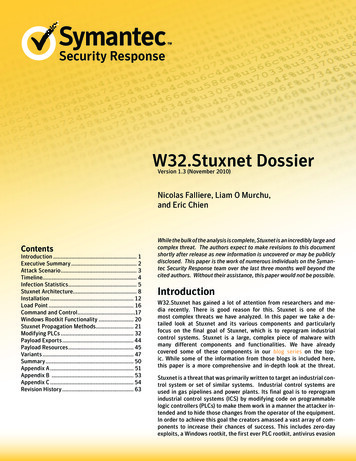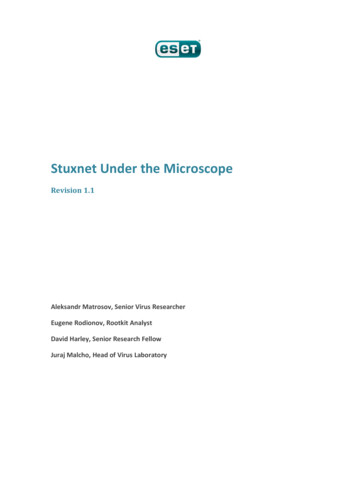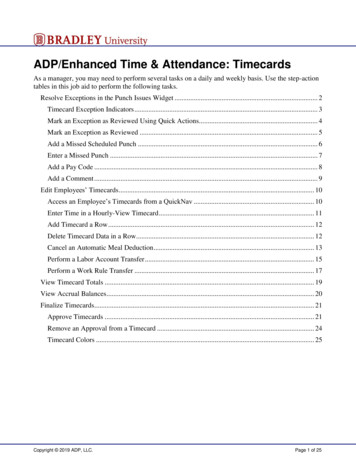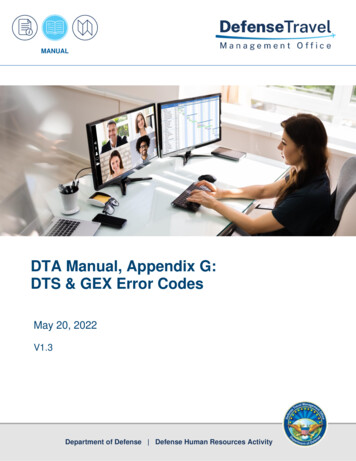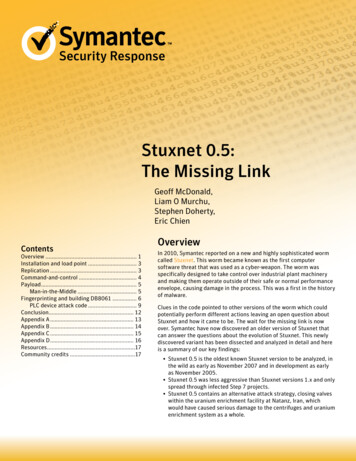
Transcription
Security ResponseStuxnet 0.5:The Missing LinkGeoff McDonald,Liam O Murchu,Stephen Doherty,Eric ChienContentsOverview. 1Installation and load point. 3Replication. 3Command-and-control. 4Payload. 5Man-in-the-Middle. 5Fingerprinting and building DB8061. 6PLC device attack code. 9Conclusion. 12Appendix A. 13Appendix B. 14Appendix C. 15Appendix D. 16Resources.17Community credits.17OverviewIn 2010, Symantec reported on a new and highly sophisticated wormcalled Stuxnet. This worm became known as the first computersoftware threat that was used as a cyber-weapon. The worm wasspecifically designed to take control over industrial plant machineryand making them operate outside of their safe or normal performanceenvelope, causing damage in the process. This was a first in the historyof malware.Clues in the code pointed to other versions of the worm which couldpotentially perform different actions leaving an open question aboutStuxnet and how it came to be. The wait for the missing link is nowover. Symantec have now discovered an older version of Stuxnet thatcan answer the questions about the evolution of Stuxnet. This newlydiscovered variant has been dissected and analyzed in detail and hereis a summary of our key findings: Stuxnet 0.5 is the oldest known Stuxnet version to be analyzed, inthe wild as early as November 2007 and in development as earlyas November 2005. Stuxnet 0.5 was less aggressive than Stuxnet versions 1.x and onlyspread through infected Step 7 projects. Stuxnet 0.5 contains an alternative attack strategy, closing valveswithin the uranium enrichment facility at Natanz, Iran, whichwould have caused serious damage to the centrifuges and uraniumenrichment system as a whole.
Stuxnet 0.5: The Missing LinkSecurity ResponseWhether Stuxnet 0.5 was successful is unclear, but later versions of Stuxnet were developed using a differentdevelopment framework, became more aggressive, and employed a different attack strategy that changed thespeeds of the centrifuges instead instead suggesting Stuxnet 0.5 did not completely fulfill the attacker’s goals.More versions of Stuxnet are known to exist, but have never been recovered.EvolutionTable 1Evolution of Stuxnet versionsStuxnet 0.5 was submitted toVersiona malware scanning service inNovember 2007 and could have0.500began operation as early as0.500November 2005. This version is0.500designed to stop compromisingcomputers on July 4, 2009, and1.001stop communicating with its1.100command-and-control (C&C)1.101servers on an earlier date of1.xJanuary 11 that same year. Thecompile timestamps found withinmost of the code appear unreliableand generally are in the range of the year 2001.DateDescriptionNovember 3, 2005C&C server registrationNovember 15, 2007Submit date to a public scanning serviceJuly 4, 2009Infection stop dateJune 22, 2009Main binary compile timestampMarch 1, 2010Main binary compile timestampApril 14, 2010Main binary compile timestampJune 24, 2012Infection stop dateTable 2Evolution of Stuxnet -3888XDescriptionTask scheduler EOPXXLoadKeyboardLayout EOPCVE-2010-2729XXXPrint spooler RCECVE-2008-4250XXXWindows Server Service RPC RCEXXXStep 7 Insecure Library LoadingXXXWinCC default passwordXXShortcut .lnk 0-2568MS09-025XBased on an internal version numberthis version of Stuxnet is 0.5, theearliest known version of the Stuxnetfamily.The only method of replication inStuxnet 0.5 is through infection ofSiemens Step 7 project files. Stuxnet0.5 does not exploit any Microsoftvulnerabilities, unlike versions 1.xwhich came later.There are differences in exploitedvulnerabilities and spreadingmechanisms between sageCall EOPTable 3Evolution of Stuxnet replicationReplication Technique0.500 1.001 1.100 1.101Step 7 project filesXUSB through Step 7 project filesXXXXXXXUSB through AutorunUSB through CVE-2010-2568Network sharesXXXWindows Server RPCXXXPrinter spoolerXXXWinCC serversXXXXXXPeer-to-peer updating through mailslotsPeer-to-peer updating through RPCXPage 2
Stuxnet 0.5: The Missing LinkSecurity ResponseStuxnet 0.5 is partly based on the Flamer platform whereas 1.x versions were based primarily on the Tildedplatform. Over time, the developers appear to have migrated more towards the Tilded platform. The developersactually re-implemented Flamer-platform components using the Tilded platform in later versions.Both the Flamer and Tilded platform code bases are different enough to suggest different developers wereinvolved.Stuxnet 0.5 also contains code to attack the valve systems in a uranium enrichment facility rather thanmodifying centrifuge speeds, as in versions 1.x of Stuxnet.Installation and load pointStuxnet 0.5 arrives as an infected Step 7 project archive containing both the s7hkimdb.dll and XR000001.MDXfiles. Using the Multiple Siemens SIMATIC Products DLL Loading Arbitrary Code Execution Vulnerability (CVE2012-3015), the S7hkimdb.dll file is executed, which then decrypts and injects the main XR00001.MDX Stuxnetbinary file into the services.exe process. Stuxnet is now executing on the system.Once injected into the services.exe process, a copy of the main Stuxnet binary and a companion DLL thatimplements the payload are saved to disk in encrypted form along with a MRXCLS.SYS load point driver. Themain Stuxnet binary refers to itself as outbreak.dll and is saved to disk as oem7a.pnf. The companion DLL thatimplements the payload refers to itself as installation.dll and saved to disk as oem7w.pnf. When the system isbooted, the MRXCLS.SYS load point driver will decrypt configuration data stored in the registry, decrypt themain Stuxnet binary, and inject it into the Explorer and Step 7 processes. The payload DLL will be decrypted aswell and injected into the Explorer process. When loading dynamic-link library (DLL) resources, Stuxnet makesuse of a module that mimics LoadLibrary rather than calling LoadLibrary itself. This technique is likelyused to avoid security software and was not seen in versions 1.x of Stuxnet.A second driver, PCIBUS.SYS, is also created which causes a forced reboot by generating a BSoD (Blue Screen ofDeath) 20 days after installation.A third driver, USBACC11.SYS, is then installed. This driver is similar to the MRXCLS.SYS driver, but insteaddecrypts and injects DLLs for peer-to-peer and C&C communication into the svchost.exe and Internet Explorerprocesses.The structure and organization as well as resource and export listings of each component is available inAppendix D.Stuxnet 0.5 also checks the current date in a variety of code paths and will not continue to spread after July 4,2009. Certain modules may also not be created or loaded if security software is present. A list is available inAppendix B.A variety of additional files are created, including log files and configuration files. A list is available in AppendixA.ReplicationStuxnet 0.5 uses one form of replication through Step 7 project archives. When a removable drive is inserted inan infected system, Stuxnet 0.5 will infect any Step 7 project archives with a .s7p or .zip file name extension onthe drive. In addition, Step 7 project archives on the local disk will also be infected.Therefore Stuxnet 0.5 spreads to additional machines through removable drives or through human-initiatedsharing of infected Step 7 project archives, for example through email.Stuxnet 0.5 infects Step 7 project archives in the same manner as Stuxnet 1.x versions (as described in W32.Page 3
Stuxnet 0.5: The Missing LinkSecurity ResponseStuxnet Dossier, Step 7 Project File Infections). The following is an example file listing of an infected Step 7project file.ApiLog/Types – modified to trigger DLL loading vulnerabilityXUTILS/links/S7P00001.DBF – configuration fileXUTILS/listen/S7000001.MDX – payload DLL (installation.dll)XUTILS/listen/XR000000.MDX – main Stuxnet binary (outbreak.dll)hOmSave7/subfolder/s7hkimdb.dll - loaderCommand-and-controlSimilar to Stuxnet 1.x versions, Stuxnet 0.5 has limited command-and-control ability. In particular, Stuxnet0.5 does not provide fine grained control to its authors. Instead, Stuxnet 0.5 can only download new code andupdate itself. Stuxnet needs to ultimately spread on isolated networks with no Internet access, therefore it hasbeen designed to be autonomous to reduce the need for robust and fine grained command-and-control. Stuxnet0.5 also uses a secondary peer-to-peer mechanism to propagate these code updates to peers on networksinaccessible to the broader Internet.Command-and-control is implemented by the inetpsp.dll file while peer-to-peer communications areimplemented by the netsimp32.dll file. Both files are loaded by the usbacc11.sys driver and then injected intothe svchost.exe and iexplore.exe processes.Stuxnet 0.5 has four C&C servers, all of which are now either unavailable or have since been registered by anunrelated party: ing4u.comad-marketing.netInterestingly, Stuxnet 0.5 is programmed to stop contacting the C&C server after January 11, 2009, even thoughthe threat is programmed to only stop spreading after a later date of July 4, 2009.The C&C server domains werecreated in 2005 and all displayedthe same front page purportingto be an Internet advertisingagency named Media Suffix(figure 1) with the tag line“Believe What the Mind CanDream”.Figure 1Internet advertising agency homepage for Stuxnet C&C serversThe servers were hosted oncommercial hosting providersin the United States, Canada,France, and Thailand. The factthat these domains were inoperation since 2005, suggeststhat the Stuxnet project startedmore than seven years ago.Page 4
Stuxnet 0.5: The Missing LinkSecurity ResponseThe first request by Stuxnet 0.5 uses the following form:http:// domain /cgi/link.php?site xxThis notifies the C&C server of an active successful infection. Next, Stuxnet 0.5 sends the following request:http:// domain /cgi/click.php?xite xx&num yy&c 1&j %x&k %x&l %xThis may download and execute a file if an update is available.The final target network for Stuxnet 0.5 was likely isolated from the Internet. To allow updates to reach thesemachines, Stuxnet 0.5 also used a peer-to-peer mechanism. As long as one updated version was introduced intothis network—for example through an infected USB key—all the other infected machines on the network couldreceive updates or new code modules.Stuxnet 0.5 uses Windows mailslots for peer-to-peer communication. Mailslots allow a process to pass amessage to another process on a remote machine. Stuxnet 0.5 enumerates all machines on the network andattempts to connect to a mailslot named \\[REMOTE MACHINE NAME]\mailslot\svchost. It then providesa callback mailslot name of \\[LOCAL MACHINE NAME]\mailslot\imnotify.Stuxnet 0.5 uses these mailslots for peer-to-peer communication and to pass code updates. In addition, Stuxnet0.5 may configure systems to allow anonymous logins and then provides the following file shares: temp msagent SYSADMIN WebFiles This allows file retrieval by peer infections. Shared files in-the-MiddleIn order to both fingerprint the target system and inject malicious Programmable Logic Controller (PLC) code,Stuxnet 0.5 replaces two Step 7 DLLs in order to hijack communications with a PLC.The first DLL, s7otbxdx.dll, is hijacked in order to insert the malicious PLC code. The same technique was used inStuxnet versions 1.x (as described in W32.Stuxnet Dossier, Modifying PLCs). Stuxnet 0.5 hooks fewer exports andverifies the CPU is a 417 PLC rather than a 315 PLC, otherwise the behavior remains generally the same.The second DLL, s7aaapix.dll, is used for fingerprinting the target system and building DB8061, a PLC data blockneeded to conduct the attack. The export AUTDoVerb is hijacked and the malicious s7otbxdx.dll file can call theexport with magic values (0x91E55A3D, 0x996AB716, 0x4A5CBB03) in order to build or provide a previouslybuilt DB8061 data block for injection. Stuxnet hijacks AUTDoVerb in order to monitor any “DOWNLOAD” verbactions, which signifies the fingerprinting and building of DB8061 must occur again in order to ensure the targetsystem is still correctly configured.Page 5
Stuxnet 0.5: The Missing LinkSecurity ResponseFingerprinting and building DB8061The building of the DB8061 block is a complicated andlengthy process.Table 4Stuxnet 0.5 hooks fewer exportsStuxnet v0.500 Stuxnet v1.xxxThrough the hijacked export, Stuxnet 0.5 will receive apointer to the most recently used block (PLC programsconsist of code and data blocks). Stuxnet 0.5 will thentraverse the project structure in order to find the symbolsused by the S7 Program in the active project. Symbolsare human designated labels representing each devicecontrolled by the PLC. The symbol labels loosely follow theANSI/ISA S5.1 Instrumentation Symbols and Identificationstandard used in Piping and Instrumentation Diagrams(P&ID).s7 eventStuxnet 0.5 uses these labels for both fingerprinting anddetermining the addresses of each device in order to modifythe behavior of those devices.s7 events7ag bub cycl read creates7ag bub read vars7ag bub read var segs7ag bub write vars7ag bub write var segs7ag link ins7ag read szls7ag read szls7ag tests7ag tests7blk deletes7blk deletes7blk findfirsts7blk findfirsts7blk findnexts7blk findnextSymbol label parsings7blk reads7blk readThe target system must be a SIMATIC 400 Station(0x14109A) or SIMATIC H-Station (0x141342), which use417 PLCs. The symbol labels must match the format:s7blk writes7blk writes7db closes7db opens7db open delimiter FunctionIdentifier delimiter CascadeModule delimiter CascadeNumber DeviceNumber A valve in module A21, also in cascade 8, and associated with centrifuge 160, would have the symbol label PVA21-8-160, for example.Each field is defined as follows:DelimiterEither space (“ “), hyphen (“-”), underscore (“ ”), or not present at all.FunctionIdentiferA string that matches a set of strings (available in Appendix C) that loosely follows the ANSI/ISA S5.1Instrumentation Symbols and Identification standard. If the string is “PIA” (Pressure Indicator Alarm), it isexpected to be followed by a one digit number. These strings will represent the device type (a valve, a transducer,or a status light, for instance).CascadeModuleMust be the string “A21” to “A28” inclusive. These strings match cascade modules in Natanz, Iran, seen publiclydescribed as “A24”, “A26”, and “A28”.CascadeNumberSingle character that is in the letter range A to R. If it is not in this letter range, it checks to see if it is two digitsin the decimal range 00 to 18. This two digit number is the number representation of the letter for A to R.Page 6
Stuxnet 0.5: The Missing LinkSecurity ResponseDeviceNumberThis is parsed in a more complex fashion depending on the device type as determined by the function identifierand caters to three possible cascade arrangements. The device type mappings to function identifiers areavailable in Appendix C.Device type 0A string of digits: If the length of the digits is less than three, the device type is changed to device type 6. Ifthe length of the digits is greater than or equal to three, the device type is changed to device type 7.Device type 1, 2, 3“##”: A two digit number in the range 1 to 25.Device type 4, 5, or 7Device type 4, 5, or 7 has three different formats:Format 1“####”: Decoded as two separate two-digit numbers representing the stage number and the centrifugenumber within the stage, respectively. The stage number must be in the decimal range 1 to 15, whichmatches with the known Natanz configuration. For each of these 15 stages, the maximum number ofexpected centrifuges in each corresponding stage is looked up in the following array.Table 5Stage numbers with expected numbers of centrifugesStageMax #12345678910111213141522468101216202420161284This means, for example, stage 3 is expected to have a second two digit number equal to 4 or less. Thisrequirement is consistent with the centrifuge arrangement within a cascade.Format 2“###”: A three digit number that must be less than 164, which is the number of centrifuges in a cascade.Format 3“##L”: A two digit number followed by a letter. The letter must be in the range A to D, and the numbermust be in the decimal range 1 to 43. This arrangement sub-divides each stage into sub-clusters of four.Device type 6“##”: A two digit number in the range 1 to 30.Device type 8, 9, B, or C“##”: A two digit number in the range 1 to 3.Page 7
Stuxnet 0.5: The Missing LinkSecurity ResponseDevice type A“## delimiter string ”: A two digit number in the range 1 to 3 with an optional string preceded by adelimiter character. The string must start with the letter S and contain the letter P. If the string is present,the device is modified to be device type 0xB instead (Flow Rate Transmitter Controller Output, rather thandevice type 0xA which is Flow Rate Transmitter Controller Input).Based on the symbol fingerprinting, the following table summarizes what devices and labels Stuxnet looks forwithin the symbol table.Table 6Summary of Stuxnet symbol label parsingDevice typeP&ID function identifierAuxiliary valve{HS, HV, PV, EP}, {ZLO,ZO},{ZLC,ZC}Centrifuge valve{MVS, RVS, VS}, {MV,RV,SV,YV}Stage pressure transducerDevices per cascadeMinMax225163164PT, PCV, PIA#, PIT, PIC, PI, PS330Centrifuge pressure transducerPT, PCV, PIA#, PIT, PIC, PI, PS0164Flow rate sensor{FIA}, {FIT}, {FITC},FIC,FT,MFC,MFM}03Symbol address parsingEach symbol label will have two corresponding addresses: -- the address in the process image area and thedirect peripheral address of the device represented by the symbol. Modifying the memory at these addressesallows the PLC to control and read the behavior of the associated device. For example, the value may be aBoolean value turning a switch on or off, or a 16-bit value representing the current temperature of the system.Addresses can be either outputs (the PLC sets the value to modify the behavior of the device) or inputs (the PLCreads the value to determine the current state of the device).Device types 0, 1, 5, and B must be output addresses and device types 2, 3, 4, 5, 6, 7, 8, 9, A, and C must beinput addresses.Values at addresses for device types 0, 1, 2, 3, 4, and 5 must be bit values. Values at addresses for device types6, 7, 8, 9, A, B, and C must be 16-bit values.Cascade rating and building DB8061After parsing the symbols and addresses for each cascade, the code inspects the configuration of each cascade.Depending on the configuration, a rating is calculated. Certain devices in certain configurations will result inhigher ratings. When complete, only the six highest-rated cascades have data written to DB8061.Finally, a flag is set signifying DB8061 has been built. This flag is reset to 0 every time the “DOWNLOAD” verb isexecuted.Page 8
Stuxnet 0.5: The Missing LinkSecurity ResponsePLC device attack codeThe code conducts an attack by closing valves in the six top rated cascades out of the possible 18 cascades. Thestates of two types of valves are modified: Centrifuge valves – a set of three valves (feed, product, tails) that work in unison per centrifuge to controluranium hexafluoride (UF6) flow into each centrifugeStage valves – one per stage to control UF6 flow into eachstage Auxiliary valves – valves that control UF6 flow into or out of each stage (stage valve) or the cascade as a wholeFigure 2Example valve configuration showing both valve types in three stages of a cascadeSimilar to version 1.x of Stuxnet, the PLC device attack code consists of a state machine with eight possiblestates:State 0 (Wait): Perform system identification and wait for the enrichment process to reach steady state beforeattack. This can take approximately 30 days.State 1 (Record): Take peripheral snapshots and build fake input blocks for replaying later.State 2 (Attack centrifuge valves): Begin replaying fake input signals. Close valves on most centrifuges.State 3 (Secondary pressure reading): Open both centrifuge and feed stage valves in the final stage of a singlecascade to obtain a low pressure reading.Page 9
Stuxnet 0.5: The Missing LinkSecurity ResponseState 4 (Wait for pressure change): Wait for desired pressure change or time limit. This can take up toapproximately two hours.State 5 (Attack auxiliary valves): Open all auxiliary valves except valves believed to be near the first feed stage(stage 10). Wait for three minutes in this state.State 6 (Wait for attack completion): Wait for six minutes while preventing any state changes.State 7 (Finish): Reset and return to state zero.Figure 3State flow diagram of 417 PLC device attack codeState 0:The code verifies the system has reached steady state by monitoring the state of each auxiliary valve and theamount of elapsed time. The valves must not change state for a period of 300 snapshots. In addition, the code determines if most of thecentrifuge valves are in the open or closed position. All cascades must be operational for three or more days, or currently be in the down state. At least one cascade must have been operating for more than 35 days, or collectively all cascades must havebeen operating for more than 297 days. Between 3 and 7 of the first 21 auxiliary valves must have been opened in the last 2 days.Page 10
Stuxnet 0.5: The Missing LinkSecurity Response Most of the pressure readings associated with the auxiliary valves must be within an expected range.Only if these all conditions are met does the code proceed to state 1.State 1:There are 21 snapshots of the peripheral I/O values that are taken one second apart. These values are stored forreplay during the attack. This prevents systems and technicians from realizing the system is no longer operating asexpected.State 2:First, the normal operating pressure is obtained and stored for replay later. For each stage a portion of all thecentrifuge valves are closed, except in the feed stage (stage 10). The centrifuge valves in the feed stage remaincompletely open, while the centrifuge valves at both the product end and tails end are completely closed.The particular centrifuge valves closed per stage are randomly chosen. The code will randomly chose a startingcentrifuge valve and then close the next one in order until the last centrifuge valve in the stage. If the total desirednumber of valves to close for that stage has not been reached, the code will continue from the first centrifuge valvein the stage until the maximum valves to close are reached.Table 7Processing stages and valves statesStageCentrifugesCentrifugevalves to 75%80%83%81%70%0%70%81%83%100%100%State 3:In state 3, in a single cascade, both centrifuge valves in stage 1 are opened and it is likely the stage valve of stage 1 isalso opened. Then, the code obtains a pressure reading at stage 1. The pressure should be relatively low. This valueis used for replay in later stages. If the normal pressure operating pressure wasn’t obtained properly in state 2, state3 is actually skipped and hardcoded default values are used instead.State 4:State 4 waits for the desired pressure change or other predetermined time limits before proceeding to state 5. If anyof the following conditions are met, the code will continue to state 5: The pressure of the stage 10 or stage 11 transducer (these are likely transducers for or near the feed stage) has anabsolute value greater than 280 units above the expected value and greater than five times the expected value. 46 minutes after the state of an auxiliary valve has been modified from the original state recorded in state 1, withthe exception of auxiliary valve number 17 which is likely a stage valve near the product end. 2 hours and 3 minutes after the attack started (since state 2) without any centrifuge valve state changes. 2 hours and 3 minutes since at least four centrifuge valve states have been modified from the original staterecorded in state 1.State 5:In state 5, all the auxiliary valves are opened except valve numbers 17, 18, and 20. Before continuing to state 6, thePage 11
Stuxnet 0.5: The Missing LinkSecurity Responsecode waits for at least 2 minutes and 53 seconds.State 6:During state 6, fake values continue to be replayed and any attempts to change device values are prevented for 6minutes and 58 seconds.State 7:Data is reset and the code returns to state 0.By closing all valves except the initial feed stage valves, UF6 will continue to flow into the system. This act alonemay cause damage to the centrifuges themselves. However, the attack expects the pressure to reach five times thenormal operating pressure. At this pressure, significant damage to the uranium enrichment system could occur andthe UF6 gas could even revert to a solid.Whether the attack succeeded in this manner or not remains unclear. Even if the attack did succeed, the attackersdecided to move to a different strategy in the Stuxnet 1.x versions, attacking the speed of the centrifuges instead.ConclusionStuxnet 0.5 clarifies the evolution and history of Stuxnet. Stuxnet clearly became more aggressive over time andswitched development platforms as it evolved from 0.5 versions to later 1.x versions.Key parts of the 417 attack code missing from versions 1.x is fully implemented in Stuxnet 0.5. This demonstratesthat the 417 attack code was the first attack strategy implemented by Stuxnet. This original 417 attack codeattempted to modify valve states during the uranium enrichment process at Natanz, Iran, to cause damage to thecentrifuges and the system as a whole.Figure 4Low-enriched uranium production (source ISIS)The success of Stuxnet 0.5 remainsunknown. However, the chartin figure 4 references uraniumenrichment production at Natanzto key milestones of Stuxnetdevelopment. Interesting eventsare dips in feed or productionamounts and lower levels ofproduction given the same orgreater feed amounts (shown asgaps between the two lines).While the discovery of Stuxnet0.5 helps to deepen our overallunderstanding of Stuxnet andwhat its goals are, versions remainunrecovered. If these are located,they may expose other secretsbehind this operation and moreclues to its origins, but obtainingthese other samples may prove tobe next to impossible.Page 12
Stuxnet 0.5: The Missing LinkSecurity ResponseAppendix AThe following registry entries are indicators of compromise: HKEY LOCAL MACHINE\SYSTEM\CurrentControlSet\Services\MRxCls HKEY LOCAL MACHINE\SYSTEM\CurrentControlSet\Services\usbacc11 HKEY USERS\ SID r\ShellRecoveryStateThe following files are indicators of compromise: %WinDir%\inf\mdmcpq3.PNF – Encrypted installation.dll%WinDir%\inf\mdmeric3.PNF – P2P configuration file%WinDir%\inf\oem6C.PNF – Log file%WinDir%\inf\oem7A.PNF – Main Stuxnet component em7w.pnf – Encrypted installation.dll%WinDir%\inf\ 67.tmp – Encrypted installation.dll%System%\drivers\mrxcls.sys – Load point driver%System%\drivers\usbacc11.sys – Load point driver for C&C server modules%System%\drivers\PCIBUS.SYS – Timer driver for generating BSoD%System%\comuid.dat%System%\netsimp32.dll – P2P communication%System%\inetpsp.dll – C&C server base.dat – Log file%AllUsersProfile%\Application Data\Microsoft\HTML nmic.fts – Configuration file for Step 7 infectionsPage 13
Stuxnet 0.5: The Missing LinkSecurity ResponseAppendix BProcesses checked for and the assumed security product associated with the process: umxagent, Tiny Personal Firewallcfgintpr, Tiny Personal Firewallumxldra, Tiny Personal Firewallamon, Tiny Activity MonitorUmxCfg, Tiny Personal FirewallUmxPol, Tiny Personal FirewallUmxTray, Tiny Personal Firewallvsmon, ZoneAlarm Personal Firewallzapro, ZoneAlarm Personal Firewallzlclient, ZoneAlarm Personal Firewalltds-3,TDS3 Trojan Defense Suiteavp, Kasperskyavpcc, Kasperskyavpm, Kasperskykavpf, Kasperskykavi, Kasperskysafensec,SafenSoftsnsmcon, SafenSoftfilemon, Sysinternals Filemonregmon, Sysinternals FilemonFrameworkService, McAfeeUpdaterUI, McAfeeshstat, McAfeenaPrdMgr, McAfeerapapp.exe, Blackice Firewallblackice.exe, Blackice Firewallblackd.exe, Blackice Firewallrcfgsvc.exepfwcfgsurrogate.exe, Tiny Personal Firewallpfwadmin.exe, Tiny Personal Firewallpersfw.exe, Kerio Personal Firewallagentw.exe, Kerio Personal Firewallagenta.exe, Kerio Personal Firewallmsascui.exe, Windows Defendermsmpeng.exe, Windows Defenderfssm32
Stuxnet 0.5 arrives as an infected Step 7 project archive containing both the s7hkimdb.dll and XR000001.MDX files. Using the Multiple Siemens SIMATIC Products DLL Loading Arbitrary Code Execution Vulnerability (CVE-2012-3015), the S7hkimdb.dll file is executed, which then decrypts and injects the main XR00001.MDX Stuxnet


